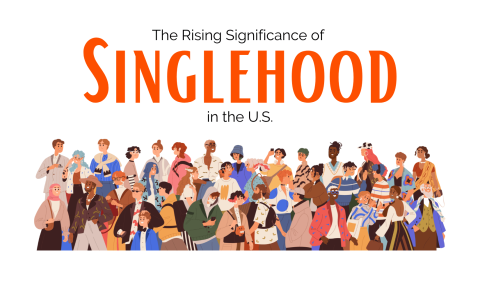The rise of singlehood is reshaping the world
So the speed with which the norm of marriage—indeed, of relationships of any sort—is being abandoned is startling. Throughout the rich world, singlehood is on the rise. Among Americans aged 25-34, the proportion living without a spouse or partner has doubled in five decades, to 50% for men and 41% for women. Since 2010, the share of people living alone has risen in 26 out of 30 rich countries. By The Economist’s calculation, the world has at least 100m more single people today than if coupling rates were still as high as in 2017. A great relationship recession is under way.
For some, this is evidence of social and moral decay. As we report, many in the “pro-natalist” movement believe that the failure of the young to settle down and procreate threatens to end Western civilisation. For others, it is evidence of admirable self-reliance. Vogue, a fashion magazine, recently suggested that for cool, ambitious young women, having a boyfriend is not merely unnecessary but “embarrassing”.
In fact, the rise of singlehood is neither straightforwardly good nor bad. Among heterosexuals (about whom there is the most research) it is largely a consequence of something clearly benign: as barriers to women in the workplace have fallen, their choices have expanded. They are far more able than in the past to live alone if they choose, and face less social stigma for doing so. The more they can support themselves financially, the less likely they are to put up with an inadequate or abusive partner. This shift has saved countless women from awful relationships, and forced many men to treat their mates better if they want to stay together.
However, it has also had unhappy knock-on effects. Flying solo can be liberating, but it can also be lonely. Plenty of singletons say they are content to remain so, especially women. But surveys in various countries suggest that 60-73% would rather be in a relationship. A poll in America in 2019 found that, although 50% of singles were not actively looking for a partner, only 27% said this was because they enjoyed being single. Many have given up, either because they despair of finding a mate, or because they don’t rate the mates on offer.
A truth universally acknowledged no more
If lots of people want to couple up but don’t, something is amiss in the relationship “market”. One problem—widespread sex-selective abortion that has led to a shortage of women and a surplus of bachelors in parts of Asia—is fortunately diminishing fast. But experts see many other obstacles.
Some think social media and dating apps have fostered unrealistic expectations (other people’s relationships look fabulous on Instagram) and excessive pickiness (most women on Bumble reportedly insist that a male must be six feet tall, thus filtering out 85% of potential matches). Another problem is the growing political gulf between young men and women, with the former leaning right and the latter leaning more to the left. Many singles insist that any partner must tick the same partisan boxes, which makes matching trickier.
Other experts point to a decline in social skills as people spend more of their lives gawping at screens. Americans of all ages socialise less in person than they did two decades ago, but the decline is especially steep among the young. Social media spread fears that women will be assaulted if they go out; and that men will be digitally shamed if a date goes badly.
Perhaps the most important factor is that, as living alone has become easier, women’s standards have grown more exacting. For many, a mediocre partner no longer seems a better bet than remaining single. Women are more likely than men to say that they want their mate to be well educated and financially solid. More men are failing to clear this moving bar, as they fall behind women educationally and the less bookish ones flounder in the job market. Men with no college degree and low earnings struggle to attract a partner; doubly so if they do not share domestic chores, or if after frequent rejection they start to dislike women, a common vice in the online “manosphere”.
Some of these problems may be self-correcting. One obvious idea is for men to grow up, do a little more housework, behave more responsibly and so turn themselves into more desirable partners. Cultural norms may impede this shift. But the prospect of avoiding lifelong loneliness and celibacy will surely serve as a powerful incentive for men to change. Many countries have been moving in this direction for years, with cleaning, cooking and child-minding more evenly split between men and women.
And yet, even in such enlightened spots as the Nordic countries, the trend towards singlehood shows no signs of abating. In Finland and Sweden roughly a third of adults live alone. At the very least, the shift is likely to exacerbate the already dramatic fall in global fertility, since single-parenting is hard and cultural taboos against it remain strong in many regions. Since young, single men commit more violent crimes, a less-coupled world could be more dangerous.
It is also possible that the relationship recession will not correct itself. A striking 7% of young singles say they would consider a robo-romance with an AI companion, and these lovebots will only get more sophisticated. AI, after all, is patient; AI is kind; it does not ask you to clean the bathroom or get a better job.
Many may worry that a world with fewer couples and children will be sadder and more atomised. Yet bemoaning the prospect will not avert it. And it is not the place of governments to overrule ordinary people’s preferences—though they should certainly try to tackle male underperformance in school. A future with far more singletons is coming. Everyone, from construction firms to the taxman, had better prepare.

